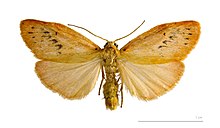Rose lichen bear
| Rose lichen bear | ||||||||||||
|---|---|---|---|---|---|---|---|---|---|---|---|---|

Rose lichen bear ( Miltochrista miniata ) |
||||||||||||
| Systematics | ||||||||||||
|
||||||||||||
| Scientific name | ||||||||||||
| Miltochrista miniata | ||||||||||||
| ( Forster , 1771) |
The rose lichen bear or rose moth ( Miltochrista miniata ) is a butterfly ( moth ) from the subfamily of the bear moth (Arctiinae).
features
The moths reach a wingspan of 23 to 27 millimeters and have an ocher-colored to orange body. The forewings, which are also colored, have a broad pale red front and outer edge. In the rear half of the wing there is a black, strongly wavy line and several points of the same color parallel to the outer edge. A fine black, slightly wavy line can also run near the base of the wing. There are specimens in which the wing edge is colored yellow instead of pale red.
The caterpillars are about 17 millimeters long and are colored black-gray. From the second segment onwards, they have long, thick, black hair, each arranged in a wreath around the segment.
Occurrence
The animals are widespread but rarely found in northern and central Europe in humid, warm mixed , quarry and moor forests and in areas densely overgrown with bushes.
Way of life
The adults are nocturnal, but you can sometimes see them visiting flowers during the day.
Flight and caterpillar times
One generation of the rose lichen bear flies from mid-June to mid-August. Occasionally, animals are found in early May or late September and early October. The caterpillars are found from August and after wintering until June of the following year.
Food of the caterpillars
The caterpillars feed on lichens such as the common yellow lichen ( Xanthoria parietina ). But they can also be raised with lettuce.
development
The females lay their eggs in small groups on tree bark. The caterpillars live on branches of deciduous trees such as beech , oak and birch . They overwinter under bark, before pupating on a branch in a dense, brownish web in which their own hair is woven in the following year.
Hazard and protection
- Red list FRG: V (on the pre-warning list).
swell
Individual evidence
- ↑ Günter Ebert (Ed.): The Butterflies of Baden-Württemberg Volume 5, Moths III (Sesiidae, Arctiidae, Noctuidae). Ulmer Verlag Stuttgart 1997. ISBN 3-8001-3481-0
- ↑ Manfred Koch : We identify butterflies. Volume 2: Bears, Spinners, Swarmers and Drills in Germany. 2nd, expanded edition. Neumann, Radebeul / Berlin 1964, DNB 452481929 , pp. 68f.
- ↑ Federal Agency for Nature Conservation (Ed.): Red List of Endangered Animals in Germany. Landwirtschaftsverlag, Münster 1998, ISBN 978-3-89624-110-8
literature
- Heiko Bellmann : The new Kosmos butterfly guide. Butterflies, caterpillars and forage plants. Franckh-Kosmos, Stuttgart 2003, ISBN 3-440-09330-1 .
- Hans-Josef Weidemann, Jochen Köhler: Moths. Weirdos and hawkers. Naturbuch-Verlag, Augsburg 1996, ISBN 3-89440-128-1 .
Web links
- www.lepiforum.de Taxonomy and photos
- Moths and Butterflies of Europe and North Africa (English)
- Miltochrista miniata in Fauna Europaea
